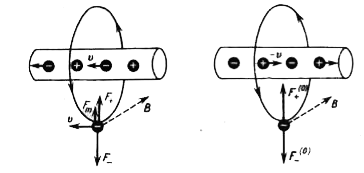Making use of the principle of relativity prove that the intensity of the transverse electric field of moving charges exceeds that of their Coulomb field.
Text Solution
Consider the following imaginary experiment. Suppose a current flows in a conduelor from the left to the right (fig. 27.3a) so that the electrons move to the left with a certain velocity 2. Let a free electron move in the same direction with the same velocity. In the reference frame xyz of the conductor there are three forces arling on the electron: the force of repulsion from the plectron cloud, Fm+1 the force of attraction to the tonic lattice, Fm, and the Lorentz force Fm acting in the same direction. It is knowo from experiment that the resultant of those three forces acts in the direction of the conductor,
Let us consider the reference frame x0y0z0 of the electrons (Fig.3b)

act on a stationary electron. The forces acting on an electron are the force oſ repulsion from the electron gas, F0+0 and the force of attraction to the moving ionic lattice. But if in the former reference frame the electron was altracted to the conductor, in accordance with the principle of relativity it will be attracted to it in any other reference frame as well. Therefore F+0>F+0 and consequently, E0+>E0−. We see that the lateral field intensity of moving charges is greater than that of stationary charges, i.e. greater than the Coulomb field.
|
Similar Questions
Knowledge Check
When subjected to a transverse electric field, cathode rays move
Adown the potential gradientBup the potential gradientCalong a hyperbolic pathDalong a circular pathA charged particle is free to move in an electric field
AIt will always move perpendicular to the line of forceBIt will always move along the line of force in the direction of the field.CIt will always move along the line of force opposite to the direction of the field.DIt will always move along the line of force in the direction of the field or opposite to the direction of the field depending on the nature of the chargeA charged particle moving in an electric field
Amust undergo change in velocityBmust undergo change in speedCmay not undergo change in velocityDmay not undergo change in speed
Suppose that an electric charge moves in a magnetic field in a plane perpendicular to the lines of induction. Prove that the orbital magnetic moment of the circulating charge is directed against the field.
View SolutionSuppose that an electric charge moves in a magnetic field in a plane perpendicular to the lines of induction. Prove that the orbital magnetic moment of the circulating charge is directed against the field.
View SolutionExplain the term electric field intensity. Establish that electric field inside a charged conductor is zero.
View SolutionThe electric field intensity on the surface of a charged conductor is
View SolutionThe electric field intensity on the surface of a charged conductor is
View Solution
